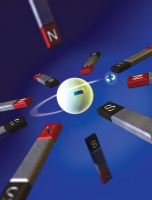








A magnetic trap is an apparatus which uses a magnetic field gradient to trap neutral particles with magnetic moments. Although such traps have been employed for many purposes in physics research, they are best known as the last stage in cooling atoms to achieve Bose–Einstein condensation. The magnetic trap (as a way of trapping very cold atoms) was first proposed by David E. Pritchard.
Operating Principle
According to the principles of quantum mechanics the magnetic moment of an atom will be quantized; that is, it will take on one of certain discrete values. If the atom is placed in a strong magnetic field, its magnetic moment will be aligned with the field. If a number of atoms are placed in the same field, they will be distributed over the various allowed values of magnetic quantum number for that atom.
If a magnetic field gradient is superimposed on the uniform field, those atoms whose magnetic moments are aligned with the field will have lower energies in a higher field. Like a ball rolling down a hill, these atoms will tend to occupy locations with higher fields and are known as "high-field-seeking" atoms. Conversely, those atoms with magnetic moments aligned opposite the field will have higher energies in a higher field, tend to occupy locations with lower fields, and are called "low-field-seeking" atoms.
It is impossible to produce a local maximum of the magnetic-field magnitude in free space; however, a local minimum may be produced. This minimum can trap atoms which are low-field-seeking if they do not have enough kinetic energy to escape the minimum. Typically, magnetic traps have relatively shallow field minima and are only able to trap atoms whose kinetic energies correspond to temperatures of a fraction of a kelvin. The field minima required for magnetic trapping can be produced in a variety of ways. These include permanent magnet traps, Ioffe configuration traps, QUIC traps and others.